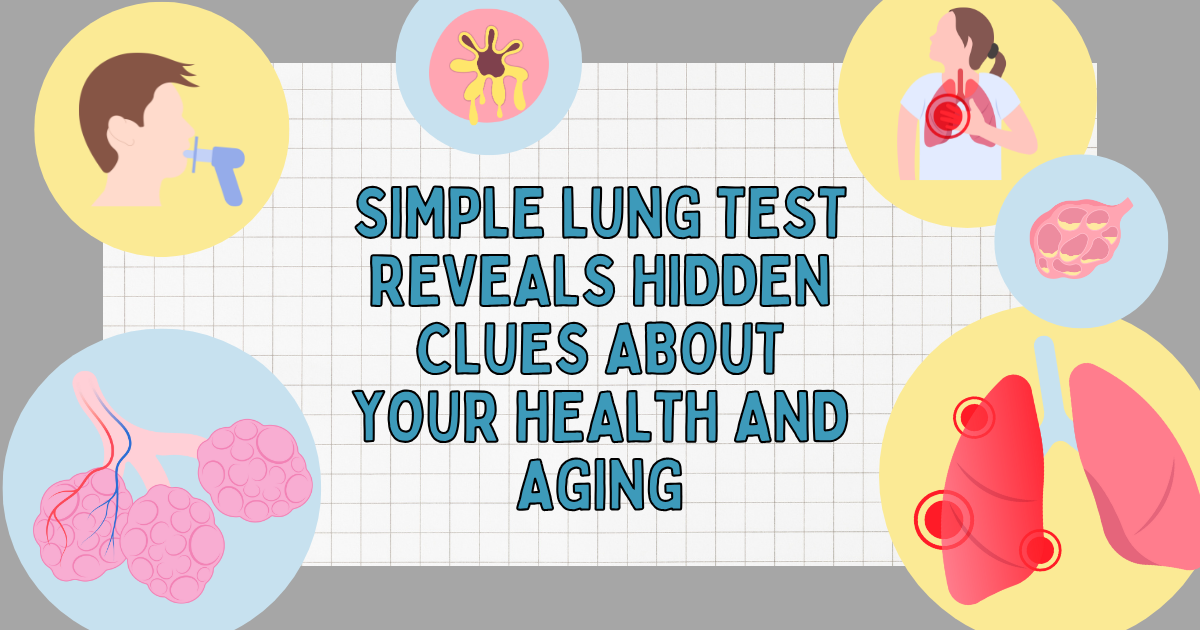How Healthy Are Your Lungs? What They Reveal About Aging and Overall Wellness
Your lungs don’t just help you breathe – they can also reveal surprising clues about your overall health and how fast your body is aging. Every breath you take exposes your lungs to pollutants, dust, microbes, and allergens, all of which can speed up the aging process of these delicate organs. And here’s the kicker: the condition of your lungs doesn’t only affect your breathing, it also plays a vital role in how the rest of your body ages.
The good news? With the right habits and simple lung function checks, you can protect your lungs and even improve their performance over time.
#1Why Lung Health Peaks in Your 20s – And What It Means for Aging
In May 2025, an international team of respiratory experts released one of the first large-scale studies examining how human lung function changes with age. Using data from nearly 30,000 men and women across the 20th century, the study revealed that lung capacity reaches its peak in the early to mid-20s. Interestingly, women typically reach their maximum lung function a few years earlier than men—after which lung performance begins a steady decline.
According to Professor Judith Garcia-Aymerich from the Barcelona Institute for Global Health, who led the research, this drop appears to be a natural and biologically programmed part of aging. However, external factors such as smoking, air pollution, and asthma flare-ups can accelerate the decline even further.
Here’s the key takeaway: the stronger your lung capacity is at its peak, the more protection you’ll have against chronic respiratory diseases and lung-related conditions later in life. And it doesn’t stop there—your lungs are also tied to surprising aspects of your overall health, including your immune system, weight regulation, and even brain function.
#2A Simple At-Home Test to Check Your Lung Health
So, how healthy are your lungs—and can you actually measure it yourself? While professional studies use advanced (and expensive) equipment, there’s a surprisingly simple DIY test you can try at home with just a few household items: a large plastic bottle, a bucket or bathtub, and a piece of rubber tubing.
Here’s how to do it (warning: it can get a little messy, so you may want to try it outside or in a sink):
Step-by-Step Lung Capacity Test:
1-Pour 200ml (7 fl oz) of water into a measuring jug, transfer it into a large plastic bottle, and mark the water level with a pen.
2-Add another 200ml, mark again, and repeat until the bottle is completely full. Each line equals 200ml.
3-Fill a bucket or bathtub with water, then submerge the bottle upside down while keeping it filled.
4-Insert the rubber tubing into the bottle’s neck (it doesn’t need to be airtight).
5-Take a deep breath and blow into the tube as hard as you can.
6-Count how many water lines are displaced as the air pushes water out of the bottle.
7-Multiply the number of lines by 200ml. For example, three lines equal 600ml. This number represents your vital lung capacity (FVC).
Your vital lung capacity (also called forced vital capacity) is an important measure of how much air your lungs can hold and expel. While this DIY test isn’t as precise as clinical methods, it can give you a rough idea of your respiratory health—and how it changes over time.
#3What Your Lung Test Results Really Mean
“The test looks at the volume of air you can breathe out, which is called **vital lung capacity (FVC),” explains John Dickinson, head of the Exercise Respiratory Clinic at the University of Kent. “The term was first used by English surgeon John Hutchinson back in the 1840s, when he noticed that people with lower lung volumes often had shorter lifespans.”
According to the American Lung Association, even in healthy non-smokers, FVC naturally declines with age—by about 0.2 liters per decade. Research suggests that a normal, healthy FVC typically ranges between 3 and 5 liters.
Still, Dickinson warns against reading too much into low numbers from a home test. “Many people struggle to fully empty their lungs, which can lead to false low readings,” he says.
The good news? There are proven ways to improve lung health and slow down age-related decline. Simple lifestyle changes—such as regular exercise, better breathing techniques, and avoiding pollutants—can help keep your lungs stronger for longer. And if your goal is to age gracefully, protecting your lung function is a vital step.
#4How Your Lungs Impact Your Overall Health
Research shows that as we age, our lungs naturally lose elasticity, the respiratory muscles (like the diaphragm) weaken, and changes in the rib cage limit its ability to expand and contract. When this decline becomes significant, it can trigger symptoms such as shortness of breath, explains Professor Judith Garcia-Aymerich. In severe cases, it may progress into chronic obstructive pulmonary disease (COPD), a condition defined by persistently low lung function.
But poor lung health doesn’t just increase the risk of respiratory diseases—it also has a ripple effect across the entire body. Studies link declining lung capacity to a wide range of conditions, including:
High blood pressure
Autoimmune disorders
Metabolic diseases such as diabetes
Physical frailty in older adults
Cognitive decline and memory problems
Simply put, your lungs are more than just breathing organs—they’re central to your long-term health and aging process.
#5When Lung Inflammation Turns Harmful
According to Professor Deborah Bowdish, if immune cells in the lungs can’t effectively clear away the particles that accumulate over time, it sets off chronic inflammation. This persistent irritation can lead to pulmonary fibrosis—a condition where scar tissue builds up, making the lungs stiffer and less efficient.
Ongoing lung inflammation doesn’t just affect breathing; it can also alter how the body responds to respiratory infections. Instead of protecting you, the immune system’s heightened response can actually cause further damage, worsening the overall decline in lung health.
#6Simple At-Home Test: Measure Your Breathing
John Dickinson, who leads the Exercise Respiratory Clinic at the University of Kent, suggests another easy way to check your lung function: testing your resting breathing frequency.
Here’s how:
Take a deep breath in.
Slowly exhale while counting the seconds.
Ideally, you should be able to breathe out for at least 11 seconds.
If you struggle to reach that threshold, it may be a sign your lung capacity could use improvement.
#7Low Lung Function and Its Link to Age-Related Diseases
Research shows that declining lung function doesn’t just affect breathing—it can actually serve as an early warning sign for a wide range of age-related health problems. Studies have found that reduced lung capacity may precede conditions such as heart disease, osteoporosis, type 2 diabetes, and even memory decline.
While the exact biological link is still not fully understood, scientists suggest that chronic lung inflammation may spread throughout the body, fueling systemic inflammation that contributes to these illnesses.
According to Professor Deborah Bowdish, this ripple effect highlights how closely connected lung health is to overall wellbeing—and why protecting your lungs as you age is more important than ever.
#8The Benefits of Healthy Lungs
The connection between lung health and overall wellbeing works in both directions. According to Professor Deborah Bowdish, maintaining strong, healthy lungs can help you stay disease-free for longer and improve your quality of life as you age.
While it’s natural for lung capacity to decline with age, this isn’t usually a cause for concern in people who actively care for their respiratory health. Dr. John Dickinson explains:
“Healthy lungs have more than enough capacity to supply the body with oxygen and remove carbon dioxide throughout life. But if the decline happens too quickly, it can negatively impact both health and quality of life.”
If you’re worried about your lung health, Dickinson recommends consulting a doctor for a professional lung function test. This test, called spirometry, measures the volume and speed of your breath to detect any potential issues early on.
#9Why You Should Get Your Lung Function Tested
A spirometry test provides a highly accurate measurement of your lung health. Using a spirometer, doctors can calculate your Forced Vital Capacity (FVC) and your Forced Expiratory Volume in one second (FEV1) — the amount of air you can forcefully exhale in just one second after a deep breath.
By comparing your FEV1/FVC ratio, doctors can determine whether your airflow is being obstructed. Taken together, these key metrics give a comprehensive picture of your respiratory function and can help detect early signs of conditions like asthma, COPD, or other lung diseases.
“Ideally, people should have their lung function tested every 10 years if they have no symptoms,” says Dr. John Dickinson. “But if you notice abnormal shortness of breath, you should get tested immediately.”
#10How to Improve Your Lung Function Naturally
Once you understand the current state of your lungs, research shows there are proven steps you can take to boost your lung capacity and slow down age-related decline
#11🏃 Stay Physically Active
Regular aerobic exercise such as walking, swimming, or cycling helps reduce airway inflammation and strengthens the muscles used for breathing. Even light daily activity can improve endurance and support better oxygen intake.
#12🥗 Adopt a Lung-Healthy Diet
Cut down on salt: Too much dietary salt can worsen lung inflammation and contribute to fibrosis.
Add fish oils & omega-3s: These help protect lung tissue from damage.
Increase antioxidants & vitamins (C & E): Found in fruits, vegetables, and nuts, they play a vital role in reducing oxidative stress and protecting lung walls.
#13🧘 Breathing Exercises
Practices such as diaphragmatic breathing and pursed-lip breathing can improve lung efficiency and help expand lung capacity.
By combining lifestyle changes with regular monitoring, you can maintain strong, resilient lungs well into later life.
#14Habits to Avoid and New Ways to Strengthen Your Lungs
According to immunologist Dawn Bowdish, one of the most effective steps you can take for better lung health is to quit smoking and vaping. Both habits introduce inflammatory chemicals that can damage your airways and accelerate lung decline.
Maintaining a healthy body weight is equally important. Daniel Craighead, assistant professor at the University of Minnesota, explains that excess abdominal fat can physically restrict the lungs from expanding fully, reducing their ability to take in enough air.
💡 But here’s the good news: you can do more than just prevent damage—you can actually improve your lung function. Since the mid-1990s, Inspiratory Muscle Training (IMT) has been recognized as a powerful technique to strengthen the muscles used for breathing. This involves inhaling through a device that provides resistance, similar to lifting weights for your lungs.
Research shows that IMT enhances respiratory muscle strength, improves exercise performance, and can even help lower blood pressure. It has been used successfully by athletes, singers, and patients with breathing difficulties such as asthma and COPD.
#15Powerbreathe and Other Methods to Train Your Lungs
The gold standard device for Inspiratory Muscle Training (IMT) is Powerbreathe, an approved medical product recognized by the UK’s National Health Service (NHS) and other global health systems. The World Health Organization (WHO) has even highlighted Powerbreathe as a valuable tool for Covid-19 recovery. Today, hospitals worldwide use it not only for patients with pulmonary fibrosis and those recovering from intensive care ventilators, but also as prehabilitation—a method to boost lung function before surgery, helping patients recover faster and more effectively.
Research led by Daniel Craighead suggests that just two daily IMT sessions of 30 breaths each are enough to strengthen the respiratory muscles.
Sabrina Brar, medical officer at Powerbreathe International, explains that using IMT is like weightlifting for your lungs. Just as lifting weights strengthens your arms and legs, IMT strengthens the diaphragm and intercostal muscles, improving endurance, slowing age-related decline, and enhancing overall lung function. Over time, resistance levels can be gradually increased to match lung strength improvements.
🎶 But devices aren’t the only way. Another enjoyable method is singing or playing a wind instrument. Researchers at the Louis Armstrong Center in New York City have used wind instruments to improve lung function in asthma patients. Others have even developed an electronic version of the ocarina flute to train breathing and strengthen respiratory muscles.
#16Singing as a Lung Workout
Mette Kaasgaard, an assistant professor at the University of Southern Denmark and a trained classical singer, has been involved in multiple trials exploring how singing may support people with COPD.
While Kaasgaard notes that singing cannot reverse existing lung damage, she believes it can still strengthen respiratory health by helping individuals better engage and control their breathing muscles.
“A key element of singing is sustaining long phrases, which demands control and flexibility of the diaphragm, intercostal muscles, and abdominal muscles,” Kaasgaard explains.
This makes singing not just an art form, but also a natural breathing exercise that improves lung efficiency.
Whether you choose to use devices like Powerbreathe, try Inspiratory Muscle Training (IMT), play a wind instrument, or sing regularly, each of these activities can help your lungs stay resilient and better handle life’s challenges — one breath at a time.






